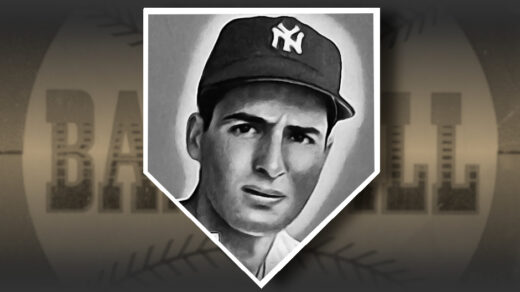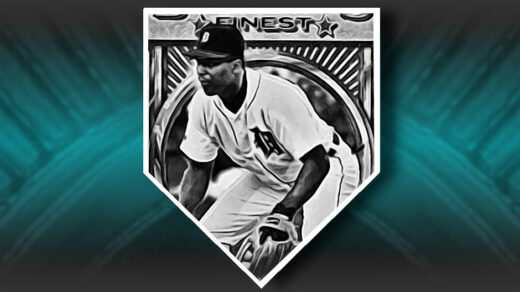Baseball is still undergoing a labor dispute so the 2022 season is currently in doubt. No worries. I have fake baseball to occupy my mind.
Thirty years ago today The Simpsons ran an episode that became one of the show’s most recognizable. “Homer at the Bat” brought in nine baseball players as guest stars, marking a departure from the show’s usual format.
The plot centers around a $1 million bet between rival businessmen over whose company softball team will win a local championship. Seeking to win at all costs, Springfield Power Plant owner Mr. Burns seeks to hire 9 baseball greats to stack the odds in his favor. When an assistant points out that every prospective ringer has been dead for years, Burns orders current players be hired to carry out the plan.
Over the years I have come back time and again to look at Mr. Burns’ original lineup. Was he better off with stars of the 19th century or their modern counterparts? There has been speculation about this before. Justin Roberts wrote about just such a comparison last year at OddSportsStories. Others, such as Michael Walsh at Nerdist, speculated on how the lineup could be improved. With baseball all but dead at the moment and the show’s anniversary here, I thought I would take a stab at determining which lineup was best.
Ground Rules
A few rules are needed to figure out which team would win a head-to-head contest. This is a game and the scoring will reflect the ebb and flow of a baseball scoreboard. We will play nine innings, each consisting of a head-to-head matchup between players of the same position. I’m using baseball statistics to determine players’ relative skill and ignoring the oddities of slow pitch softball. The only metric used to calculate scoring will be wins above replacement (WAR) and will encompass both offensive and defensive contributions. WAR figures will be taken from lifetime totals and displayed as an average WAR per 100 games played. This produces scoring totals that can be rounded to meaningful whole numbers and totaled to get a final score similar to the 48-47 final score observed in one of the Simpsons’ softball games. This scoring system will be very simplistic – other fans will produce much more rigorous comparisons elsewhere.
Two teams will be presented. The Zephyrs, so named because of the logo on Mr. Burns’ uniform, represents his original projected lineup. Modern players are identified as the Isotopes, the name under which they played in the softball league.
First Inning: First Base
The Zephyrs are first on the board with Cap Anson batting. Anson generated 3.61 WAR/100 games, good for 4 runs under our rules. Anson, playing from 1871-1897, was one of the game’s early superstars and about as ruthless as Mr. Burns. He frequently bet on baseball, is said to have skipped straight from 1st to 3rd when the umpire was distracted, bolted to the newly formed National League to avoid the sport’s rules, and pretty much institutionalized the racial segregation that dominated the sport until 1947. He wasn’t a great guy, but he won games. He was the first with 3,000 hits, struck out less than 3% of the time, and set multiple records that took decades to break.
Facing off against Anson in the bottom of the first is Yankees favorite Don Mattingly. Mattingly started off his career strong, but by the show’s airing in 1992 was seeing his knees and back wear down. He was very good, but his .307 batting average and .361 wOBA were no match for Anson’s .333 and .393. Mattingly was a step down from Anson on the field, but he still carries the Mr. Congeniality award. While not intentional, the show reflects this with him warmly greeting Mr. Smithers and offering him a meal.
| TEAM | 1 | 2 | 3 | 4 | 5 | 6 | 7 | 8 | 9 | TOTAL |
|---|---|---|---|---|---|---|---|---|---|---|
| ZEPHYRS | 4 | 4 | ||||||||
| ISOTOPES | 2 | 2 |
Second Inning: Second Base
So far it looks like Burns did his homework for the Zephyrs. Second baseman Nap Lajoie is one of the greatest to ever play the position and is a better player than Anson. He was so good that Cleveland named its baseball team after him, leaving the Cleveland Naps as a forerunner to today’s Cleveland Guardians. More than 100 career wins above replacement is good for a 100 game average of 4.12 and 4 runs in today’s contest.
Who did Mr. Smithers find to replace Lajoie? Ryne Sandberg rejected the show, leaving former LA-resident Steve Sax to fill the position. Sax was popular after helping the Dodgers get to the postseason several times in the 1980s but isn’t remotely in the same league as Lajoie when it came to performance. Lajoie, a player in baseball’s notorious “deadball” era, hit 50% more home runs than Sax while batting more than 50 points higher. Sax was good enough to get a point on the board, but the Isotopes are still losing ground.
| TEAM | 1 | 2 | 3 | 4 | 5 | 6 | 7 | 8 | 9 | TOTAL |
|---|---|---|---|---|---|---|---|---|---|---|
| ZEPHYRS | 4 | 4 | | | | | | | | 8 |
| ISOTOPES | 2 | 1 | | | | | | | | 3 |
The ‘Topes are down by 5 runs going into the third. Perhaps things will turn around.
Third Inning: Shortstop
Nope.
The Zephyrs shortstop still ranks 5th in all time WAR and is way ahead of all the others at his position. 100 years after he last played, Honus Wagner still ranks among the game’s ten greatest players. The game’s historians agreed, giving him the same number of votes for the Hall of Fame as Babe Ruth when they were both elected in the Hall’s inaugural class.
Ozzie Smith is one of the best defensive players at his position. Unfortunately, his offense wasn’t in the same league. He scratched out nearly 2,500 career hits, but it took him an inordinate number of plate appearances to get there. While Wagner hit nearly one third of his drives for extra bases, Smith had to manufacture offense with stolen bases. This didn’t gain any ground against the better Wagner, as the latter stole several hundred more bases than the speedy Cardinals shortstop.
| TEAM | 1 | 2 | 3 | 4 | 5 | 6 | 7 | 8 | 9 | TOTAL |
|---|---|---|---|---|---|---|---|---|---|---|
| ZEPHYRS | 4 | 4 | 5 | | | | | | | 13 |
| ISOTOPES | 2 | 1 | 3 | | | | | | | 6 |
Fourth Inning: Third Base
After Wagner’s career wound down the Pittsburgh Pirates brought aboard Pie Traynor. Traynor blossomed into an excellent hitter and is generally seen as the best third baseman of the pre-WW2 era. His WAR metrics are not as dominant as those appearing earlier in the game, so perhaps the Isotopes have an opening.
*Crack* Wade Boggs has entered the game and the ‘Topes are making up for lost time. Boggs turned out to have the highest per game WAR of any of the team’s position players and is arguably one of the finest third basemen in the game’s history. Commentary from the Simpsons’ production staff indicates he has an impressive ability to belch on command and nearly ended up providing the gastrointestinal sound effects for future episodes.
| TEAM | 1 | 2 | 3 | 4 | 5 | 6 | 7 | 8 | 9 | TOTAL |
|---|---|---|---|---|---|---|---|---|---|---|
| ZEPHYRS | 4 | 4 | 5 | 2 | | | | | | 15 |
| ISOTOPES | 2 | 1 | 3 | 4 | | | | | | 10 |
Fifth Inning: Catcher
Gabby Street was Mr. Burns’ first choice to catch for the company softball team. Perhaps he remembered the light-hitting catcher securing a ball thrown from the top of the Washington Monument in a publicity stunt. Catching was his strength, while his offense was only generously given the title “offense.” Street batted .208 and has less than 100 runs to his credit over his entire career. His offense and defense largely canceled each other out, creating a WAR/100 game average of just 0.1, a figure that easily rounds down to zero for our purposes.
What about the bottom of the inning and the appearance of Mike Scioscia? 1992 would be the final season for the Dodgers catcher, but he put up better numbers on both an offense and defense than Street. In fact, every single year of Sciocisa’s career outpaced Street’s best year. His serviceable batting skills coupled with good defensive metrics generate 1.98 WAR/100 games, making this inning 2-0 in favor of the Isotopes.
| TEAM | 1 | 2 | 3 | 4 | 5 | 6 | 7 | 8 | 9 | TOTAL |
|---|---|---|---|---|---|---|---|---|---|---|
| ZEPHYRS | 4 | 4 | 5 | 2 | 0 | 15 | ||||
| ISOTOPES | 2 | 1 | 3 | 4 | 2 | 12 |
Scioscia was not the first choice to fill in for Street, who had died in 1951. Carlton Fisk was approached to handle backstop duties for the Springfield Isotopes but turned down the show’s producers. Given Fisk’s love of botany, fans missed an excellent opportunity to see a Little Shop of Horrors plant-based mishap keep him off the field.
Sixth Inning: Left Field
Did you know the Athletics provided both left fielders for the game? Shoeless Joe Jackson played 10 games with the A’s before joining Nap Lajoie in Cleveland. While Jackson is rarely mentioned in connection with the A’s, Jose Canseco’s legacy is largely inseparable from the team. Both players also occupy a darker side of the game’s history. Jackson was banned from the sport after becoming involved in a gambling conspiracy to throw the 1919 World Series. Canseco became known as the godfather of steroids and considers himself exiled from the game as a result.
Jackson was on his way to becoming an all-time great along the lines of a Nap Lajoie or Honus Wagner. His per game metrics are a bit higher than they otherwise would have been as his banishment prevented an age related decline from ever affecting his statistics. Jackson’s .356 career batting average is 49 points higher than Canseco’s best single season mark. Canseco hit tons of home runs, but Jackson was a more complete player. Both played outfield but the latter’s time as a designated hitter kept his WAR metrics restricted.
| TEAM | 1 | 2 | 3 | 4 | 5 | 6 | 7 | 8 | 9 | TOTAL |
|---|---|---|---|---|---|---|---|---|---|---|
| ZEPHYRS | 4 | 4 | 5 | 2 | 0 | 5 | | | | 20 |
| ISOTOPES | 2 | 1 | 3 | 4 | 2 | 2 | | | | 14 |
Seventh Inning: Center Field
The Zephyers’ Harry Hooper was primarily known as a defensive power in the outfield. His offensive numbers were solid, but not too worthy of praise much higher than that assessment. Perhaps Mr. Burns appreciated his business skills as Hooper would go on to accumulate interests in a wide variety of ventures after his playing days came to an end. Hooper manages to put two more runs on the board in the top of the inning.
*Cue the Seventh Inning Stretch with Terry Cashman performing “Talkin’ Softball”*
Ken Griffey, Jr. was still a year away from his breakout 1993 season when Homer at the Bat aired. He did, however, produce lights out numbers in the ensuing 10 years that carried his WAR totals into rarified territory. Ironically, Griffey suffers from PED-induced side effects in the Simpsons episode while his career is largely seen as one of the few untouched by the scandals. Griffey posts 3 runs for the Isotopes in the bottom of the inning.
| TEAM | 1 | 2 | 3 | 4 | 5 | 6 | 7 | 8 | 9 | TOTAL |
|---|---|---|---|---|---|---|---|---|---|---|
| ZEPHYRS | 4 | 4 | 5 | 2 | 0 | 5 | 2 | | | 22 |
| ISOTOPES | 2 | 1 | 3 | 4 | 2 | 2 | 3 | | | 17 |
Eighth Inning: Right Field
Here’s where things get weird. When Mr. Smithers questions the choice of older players in Mr. Burns’ original roster he points out that the Zephyrs’ right fielder had been dead since 1862. Jim Creighton is shown playing that position, an odd choice considering that he was primarily a pitcher. Playing for the Brooklyn Excelsiors, Creighton actually predates what we recognize today as professional baseball. He played in an era in which batters could direct a pitcher where in the strike zone to throw the ball. Creighton was the first true pitcher, as prior to his arrival the position served only to begin the play and give batters an easy target to whack towards the fielders. He reinvented the role, technically following the rules that then called for an underhand throwing motion while subversively trying to make batters swing and miss. He effectively invented the fastball as a defensive weapon. There is no reliable analog to WAR covering this period. Given his impact on the sport (effectively separating baseball from cricket), I am assigning 5 runs to the Zephyrs.
Darryl Strawberry had 9 homeruns in 9 at bats in the first 8 innings of the Springfield championship game before being subbed out for Homer Simpson. Strawberry had a troubled career with drug problems derailing what promised to be the second coming of Willie Mays’ bat in New York. Still, the first decade of his career was strong enough to generate 3 more runs for the Isotopes.
| TEAM | 1 | 2 | 3 | 4 | 5 | 6 | 7 | 8 | 9 | TOTAL |
|---|---|---|---|---|---|---|---|---|---|---|
| ZEPHYRS | 4 | 4 | 5 | 2 | 0 | 5 | 2 | 5 | | 27 |
| ISOTOPES | 2 | 1 | 3 | 4 | 2 | 2 | 3 | 3 | | 20 |
Ninth Inning: Pitching
Mr. Burns selected Mordecai “Three Finger” Brown as his pitcher, a decision likely based as much on his absurd nickname as his Hall of Fame pitching career. A more calculating manager would have zeroed in on Walter Johnson or Cy Young to take the mound, but Brown will suffice. Excellent control and few baserunners marked his career with less than 2 walks issued per 9 innings and opponents batting .232. He added 10 wins above replacement for every 100 appearances, giving the Zephyrs a total of 37 runs.
A chemically enhanced Roger Clemens stepped in to save the Isotopes. Originally seeking Nolan Ryan for the part (he turned it down), The Simpsons landed the Red Sox ace. Lacking the pinpoint control of Brown, he made up for it with power. Clemens struck out nearly one batter per inning in an era in which this wasn’t an everyday occurrence. The result was effective, with batters hitting only .226 against him.
| TEAM | 1 | 2 | 3 | 4 | 5 | 6 | 7 | 8 | 9 | TOTAL |
|---|---|---|---|---|---|---|---|---|---|---|
| ZEPHYRS | 4 | 4 | 5 | 2 | 0 | 5 | 2 | 5 | 10 | 37 |
| ISOTOPES | 2 | 1 | 3 | 4 | 2 | 2 | 3 | 3 | 19 | 39 |
‘Topes Win! ‘Topes Win!
The Springfield Isotopes pulled out the come from behind victory with a score of 39-37. Two controversial late-inning developments potentially affected the outcome.
A scoring quirk will make this game closer than the score would indicate. Scoring has been based on the average WAR per 100 games generated over a career. Pitchers don’t play 162 games per season. Sore arms and the advent of pitching rotations bring in pitchers for perhaps 40 games in a season. Offsetting this is the fact that pitchers battle opposing batters every moment of a game while position players touch the ball for a very small percentage of playing time. For continuity purposes I am sticking with WAR per 100 games, but this could have easily been WAR per 25 games. A score of 30-25 favoring the Zephyrs would result from this change.
The 8th inning awarded 5 runs to the Zephyrs for the performance of Jim Creighton. With limited statistical data predating much of the sport, there is substantial doubt as to how much credit should be given. No credit for Creighton would make the game a 25-25 tie if pitchers were given a reduced weighting.
Please bring back real baseball.




